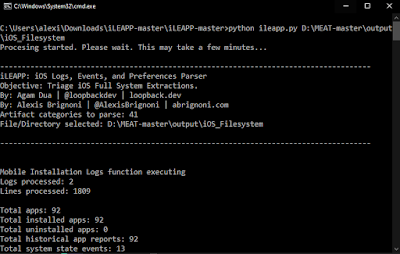Make no mistake, M.E.A.T. had me at hello. iOS extraction open source python software by Jack Farley (@JackFarley248). It creates a file system extraction of jailbroken iOS devices using Apple File Conduit 2.
 |
| Meat puns are the wurst |
Get some M.E.A.T. here:
https://github.com/jfarley248/MEATI also highly recommend Jack's iTunes Backup Reader. It takes unencrypted iTunes backups an recreates the full file system structure. Get it here:
https://github.com/jfarley248/iTunes_Backup_ReaderUpdate:
Video version
Long version
I love Twitter but sometimes the algorithm, or just plain bad timing, has me miss some of the most juicy tweets and announcements. Thanks to Phill Moore (@phillmoore) I was made aware of the newly release Mobile Evidence Acquisition Toolkit (M.E.A.T.) by Jack Farley. I've been following his work and using his code for a while now. I cannot encourage you more to give his scripts a shot. From a learning/training use to a data acquisition and validation perspective, these tools are worth your time.
M.E.A.T. will give you a full file system extraction from iOS devices with a single command. If you had the pleasure (or pain) of extracting a full file system over WiFi using SSH you will appreciate the speed and simplicity of this USB based method. The following is a quick guide and review on the scripts and how to execute them.
Pre-requisites & download
Go to the github repo for M.E.A.T and download the scripts. As stated in the repo's readme you will need a Windows machine with Python 3.7.4 or 3.7.2 installed. Before running the scripts make sure you go unzip the downloaded file and run the following command from the root directory of the scripts.
pip install -r requirements.txtThis will make sure all the dependencies are installed. Also your target iOS device will need to be jailbroken and have Apple File Conduit 2 (AFC2) installed via Cydia.
A great guide on what jailbreaking entails with emphasis on the Checkra1n implementation of Checkma8 see Ian Whiffin & Shafik G. Punja blog post here.
Assuming the target device is jailbroken with AFC2 and your device has Python with all proper dependencies you are ready to go.
Let's beat it
Connect your iOS device to your computer. As expected make sure to select Trust Device at the prompt on your iOS device and provide the proper pin/code/pass as needed. With trust established we can connect to the phone.
Navigate to the script's root directory. It will look like this:
Open a command line interface at this location and run the following command to examine the help documentation.
python MEAT.py -hYou will see the following. Pretty self-explanatory.
 |
| Sick MEAT ascii art. I think it is cured by now. |
As seen in the help you can generate MD5 and SHA1 hashes for your extracted files. Delicious!
For this example I will run a file system extraction that will pull everything from the root of the device. The logical option will only extract data from the \private\var\mobile\Media directory. Be aware that the -v option will add some additional time to the extraction since you will be getting a lot of output sent to the screen.
Before starting the extraction I create the output folder in the same directory from where I am running the script. You don't have to do this of course. I do because it shortens how long the extraction command will be. In this example I typed the following to create my output directory:
mkdir outputTo start the extraction process in verbose mode without hashing type this:
python MEAT.py -iOS -filesystem -o ./output -vAt the start of the process you will see your target device information.
Since we are running in verbose mode you will see a flying matrix movie like screen of text on screen.
These are files being extracted. `The process on my device took around 90 minutes for a 15 GB extraction in verbose mode. When done you will have an iOS file system folder and a log. If you selected the hashing option then you would have seen a csv file with all the calculated hashes.
Be aware that you might find some difficulty running scripts on some older iOS devices. This is OK. No software executes a 100% of the time. That is to be expected as well as these scripts getting better with time. The fact that even though these were released a few days ago you are able to extract so much from so many iOS devices is amazing.
Here is the contents of the iOS-Filesystem directory.
 |
| Now what? |
With the extraction done you can parse it with your favorite digital forensics commercial tools. In order to keep the open source vibe going I will parse it with my own tool, the iOS Logs Events And Properties Parser (iLEAPP), and see what we can get. You can get iLEAPP here:
https://github.com/abrignoni/iLEAPPAs expected the tool parses the artifacts and provides a report. Currently I am updating the reporting function in iLEAPP so it has searching by report section and an overall more polished look. Credit goes to Yogesh Khatri (@swiftforensics) for his work on the reporting features in ALEAPP that I am now porting to iLEAPP.
iLEAPP command line execution:
iLEAPP reporting from M.E.A.T. extraction:
Conclusion:
We are truly living in the golden age of mobile digital forensics in the midst of a vibrant community of practitioners that work together to make the industry, tools, and knowledge more useful and accessible. Again, a big thank you to Jack Farley for his work on this tool. It is greatly appreciated.
As always, I can be reached on twitter @AlexisBrignoni and email 4n6[at]abrignoni[dot]com.





